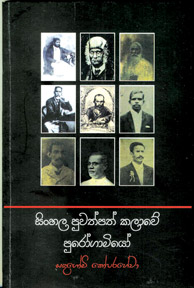Pioneers of Sinhala journalism
 Coperahewa has
compiled one book on the trends as set up by Wickramasinghe which has
come out as a separate volume titled ‘Martin Wickramasinghe – Puvatpat
Kala Mehevara (2012). More recent trendsetters of the calibre of D B
DHanapala (1905 – 1971), Hemapala Munidasa (1903 – 1957) and David
Karunaratne (1918 – 1981) too are featured in this work Coperahewa has
compiled one book on the trends as set up by Wickramasinghe which has
come out as a separate volume titled ‘Martin Wickramasinghe – Puvatpat
Kala Mehevara (2012). More recent trendsetters of the calibre of D B
DHanapala (1905 – 1971), Hemapala Munidasa (1903 – 1957) and David
Karunaratne (1918 – 1981) too are featured in this work
A student of the literary history of a country and the history of the
growth of mass media in a country cannot afford to miss the value of the
profiles of media persons behind each mass media channel. At a time when
Sri Lanka (then Ceylon) was introduced to the print medium, one of the
main factors one observes is the strength of the men who shouldered the
development of the same, making the recipient or the reader in the case
to be aware of the socio cultural values embedded in the country. This
paved the way to build a special type of indigenous journalism that
lasted for over a period of at least 75 years or more.
Dr Sandagomi Coperahewa, a senior lecturer in Sinhala studies at the
Colombo University, has embarked on a lofty project of an in depth
studies of the contents of the Sinhala newspapers from its very
inception. Furthermore he has intensively collected material for the
compilation of a series of profiles of the pioneer Sinhala journalists,
inclusive of such scholars as Koggala Johannas Pandita Tilaka (1830 –
1867). He is justified as the journalist who spearheaded the debate
known as ‘savsaddam vadaya’. This, according to Coperahewa, has
triggered off an active interest in the use of language which is more
akin to terminologies, carried down the ages by those who followed the
trend.
Scholarly journalists
Perhaps as hinted in the work, the journalist had been a founder of
certain new uses that had entered the field of journalism, which we
nowadays denote by this term ‘key terms’. Then comes the scholar
journalist Pandit M Dharmaratne (1846 – 1925) who had been the founder
author of ‘Lakmini Pahana’, a paper later edited by the well known
scholar Munidasa Cumaratunga (1887 – 1944) about whom the author
Coperahewa devotes more space.
 The profiles are arranged in the chronological manner enabling the
interested reader to gather the historical development of the patterns
and crosscurrents that had led the way to change the format of
communication insights of each journalist. Humour too had played a
significant role in the creation of readership in the country. The profiles are arranged in the chronological manner enabling the
interested reader to gather the historical development of the patterns
and crosscurrents that had led the way to change the format of
communication insights of each journalist. Humour too had played a
significant role in the creation of readership in the country.
One example is the profile G D Palis Appuhamy (1847-1910) who edited
‘Kavata Katikaya’. Then comes the profile of the dramatist cum
journalist C Don Bastian (1852 – 1921). He is accorded honour of being
the first editor of a daily paper called ‘Dinapata Pravurthi’. He is
also remembered for several original works, and adaptations of
occidental playscripts inclusive of ‘Rome and Juliet’.
The other journalist in line, who had been cited as a trendsetter of
the Sinhala newspaper is Weragama Punchibandara (1856 – 1892) is
honoured for the newspaper titled as ‘Sarasavi Sandarasa’. In all there
are eighteen profiles, some briefly written, and perhaps one fine day
the compiler may have the chance of developing them into lengths and
interesting works.
There is a need in the modern day communication studies to rediscover
some of the works of pioneer journalist cum classical writers of the
caliber of Piyadasa Sirisena (1875 – 1946), Piyasena Nissanka (1890 –
1970), Martin Wickramasinghe (1890 – 1976), Julius de Lanerole (1896 –
1964).
The author Coperahewa has compiled one book on the trends as set up
by Wickramasinghe which has come out as a separate volume titled ‘Martin
Wickramasinghe – Puvatpat Kala Mehevara (2012). More recent trendsetters
of the calibre of D B DHanapala (1905 – 1971), Hemapala Munidasa (1903 –
1957) and David Karunaratne (1918 – 1981) too are featured in this work.
Covering each profile, Coperahewa has cited sources and bibliography
from which he has gathered material for his research.
This work of the scholar Coperahewa serves two main purposes.
Firstly, each profile underlines a social history of the era in which
the media (print) had evolved.
Secondly the work underlines the challenges faced by each journalist
to strive towards a better communication culture, which we need today.
It is observed that each journalist included in this, had had an impact
on the society, which in turn is factor that has to be rediscovered
today.
[email protected]
|





